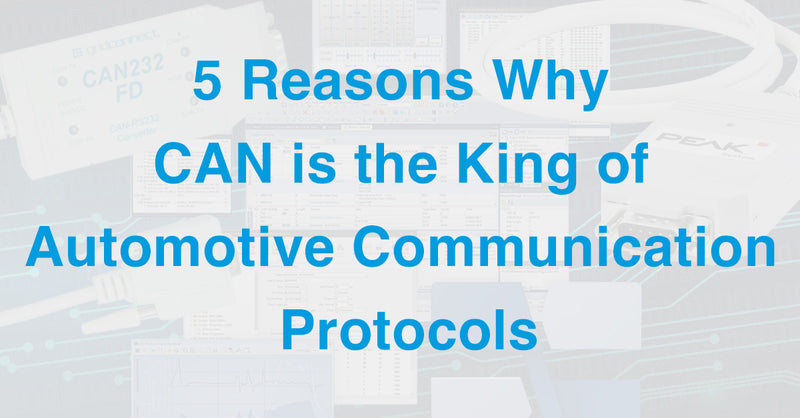In the early 1980s, vehicle manufacturing started becoming more complicated due to an increase in electronic devices being added to the vehicle. Devices like gear and lighting control, anti-lock braking systems, and active suspension needed to function in unison and share data. Previously, different nodes within the vehicle could just communicate using point-to-point analogue signal lines where each device had a direct line of communication with all the devices with which it needed to share data. This, as you can imagine, led to an excessive amount of wires.
In 1985, The Bosch Company developed the Controller Area Network (CAN) to allow these electronic devices to share near real-time data with one another over a common serial bus. Today, CAN continues to grow in popularity in the automotive industry. This article will provide five reasons why CAN is the king of automotive communications protocols, and how Grid Connect can help you stay connected.
#1: CAN is Efficient
CAN’s efficiency is practically unmatched, and has led to the creation of more advanced automotive protocols like J1939, which is commonly used in heavy-duty vehicles. It was designed to send small amounts of data (8 bytes or less) to a bus in the form of frames. After all, at the time of its conception, cars only had small amounts of data to send. Every node on the CAN network can send and receive messages. The nodes can determine if a message is relevant to them based on the frame identifier. Just one message can be transmitted on a CAN bus at a given time. Using an arbitration ID on the CAN frame, messages are given priority. Messages with higher priority will win arbitration while those with lower priority must wait until the bus becomes idle once more. This is known as non-destructive bus arbitration.
#2: CAN is Inexpensive
Since its initial release, CAN has continued to grow in popularity. Today, more than twenty manufacturers offer low-cost IC CAN controllers, embedded CPU peripherals and transceivers. Its availability and ease of implementation have helped it to become adopted in a wide variety of applications. In the automobile industry,CAN is a low-cost alternative to point-to-point wiring systems which were popular in earlier vehicles. The year 1986 marked the first vehicle to utilize a CAN bus, the BMW 850 coupe. This reduced the vehicle’s wiring by 1.25 miles, and it weighed 110 pounds less than the previous model. Using CAN, manufacturers can reduce their material costs while consumers can enjoy the benefits of driving a less heavy vehicle, such as better fuel economy.
#3: CAN is Fast
The original CAN bus protocol (ISO 11898) can support 1 Mbit/s at a bus length of up to 40 meters in length. Combine the speed with the small message size and low overhead and messages can be communicated to the network very quickly. This was great for most Automotive applications and why it became so widely adapted. However as time passed, more and more intelligent nodes were added to vehicles, and data intensive devices began to strain the limits of classic CAN, leading to the introduction of the CAN FD (Flexible Data rate) protocol in 2015. This new FD standard allowed for CAN data payload to be increased from 8 bytes to 64 bytes without a change in overall bus load. The third and most recent evolution on CAN is CAN XL (extra long). It was developed to provide higher data rates and frame payloads up to 2048 bytes. While its adoption has been limited in the automotive industry as a relatively new protocol, CAN XL is likely to grow in popularity as it offers interoperability with existing CAN FD networks. CAN XL fills a gap between Ethernet and CAN FD.
#4: CAN is Flexible
Because it is a message-based protocol, nodes on the network need no address identifiers. Message identifiers simply detail the type of data being sent, not the source of the data or where it is going. For that reason, nodes can be added and removed from the network without any hardware or software modification being necessary. This is one of the many reasons why engineers like working with CAN--it is so easy to grow the network. It's also uncomplicated to add devices to the network for diagnostic monitoring and troubleshooting.
#5: CAN is Robust
CAN features high-speed data lines that are resistant to electrical disturbances. Some CAN controllers and transceivers also come in extended temperature ranges for the most demanding environments. CAN also offers built-in error detection. When an error is detected, nodes produce a special error flag message and will censor offending messages from traveling throughout the network. Nodes generating faulty messages will also censor themselves if they send too many errors. When this happens, these nodes go “bus off” and can no longer send network traffic.
Grid Connect Helps You Stay Connected
Grid Connect helps you stay connected by offering unmatched technical expertise in CANbus solutions. As a leading provider of CAN hardware, we understand the challenges that come from monitoring your CAN networks and diagnosing faults. Giving you the tools you need to make fast diagnoses is what we do best. We pride ourselves in the quality of our products, our dedication to customer service, and fair pricing. Here are two products that we recommend.
RS-232 to CAN FD Converter
The RS-232 to CAN FD Converter allows you to provide two-way communication between a high-speed CAN network and a RS-232 interface. There are two operating modes associated with this converter.
Tunnel Mode
Tunnel Mode allows a controller on the CAN bus to stream messages to and from a serial device. This mode has been enhanced to support larger CAN FD packets.
Command Mode
Command Mode allows messages to flow to and from a RS-232 port and offers the ability to filter messages to specify the CAN identifiers you wish to receive.
PCAN USB Adapter
The PCAN USB Adapter allows you to connect a CAN bus to any PC or laptop device via a USB port. From there, you can:
- Monitor a CAN network
- Write a CAN program
- Communicate with CAN devices within your network.
If you need a program that enables simultaneous communication between multiple CAN and CAN FD buses, look no further than the PCAN Explorer 6 software.
PCAN Explorer 6
PCAN Explorer 6 is an upgrade from the Explorer 5, and allows you to send messages directly into your CAN network as well as transmission lists, which is beneficial to you as you run simulations. It also allows you to connect with multiple CAN interfaces independent of the Peak hardware interface.
To perform all these functions within a J1939 network, you can use the J1939 Add-in for PCAN Explorer 6. This allows you to illustrate communication on a CAN bus within utility vehicles in order to transmit the control information and diagnostics data.
Need Support?
We hope that you found the information in this article helpful. If you still have additional questions, or want to know how Grid Connect can serve you, feel free to get in touch.
Thanks for reading!











